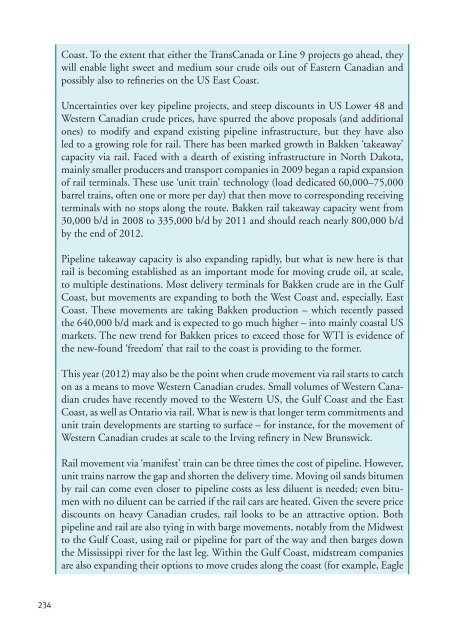World Oil Outlook - Opec
World Oil Outlook - Opec
World Oil Outlook - Opec
- TAGS
- world
- outlook
- opec
- www.opec.org
You also want an ePaper? Increase the reach of your titles
YUMPU automatically turns print PDFs into web optimized ePapers that Google loves.
234<br />
Coast. To the extent that either the TransCanada or Line 9 projects go ahead, they<br />
will enable light sweet and medium sour crude oils out of Eastern Canadian and<br />
possibly also to refineries on the US East Coast.<br />
Uncertainties over key pipeline projects, and steep discounts in US Lower 48 and<br />
Western Canadian crude prices, have spurred the above proposals (and additional<br />
ones) to modify and expand existing pipeline infrastructure, but they have also<br />
led to a growing role for rail. There has been marked growth in Bakken ‘takeaway’<br />
capacity via rail. Faced with a dearth of existing infrastructure in North Dakota,<br />
mainly smaller producers and transport companies in 2009 began a rapid expansion<br />
of rail terminals. These use ‘unit train’ technology (load dedicated 60,000–75,000<br />
barrel trains, often one or more per day) that then move to corresponding receiving<br />
terminals with no stops along the route. Bakken rail takeaway capacity went from<br />
30,000 b/d in 2008 to 335,000 b/d by 2011 and should reach nearly 800,000 b/d<br />
by the end of 2012.<br />
Pipeline takeaway capacity is also expanding rapidly, but what is new here is that<br />
rail is becoming established as an important mode for moving crude oil, at scale,<br />
to multiple destinations. Most delivery terminals for Bakken crude are in the Gulf<br />
Coast, but movements are expanding to both the West Coast and, especially, East<br />
Coast. These movements are taking Bakken production – which recently passed<br />
the 640,000 b/d mark and is expected to go much higher – into mainly coastal US<br />
markets. The new trend for Bakken prices to exceed those for WTI is evidence of<br />
the new-found ‘freedom’ that rail to the coast is providing to the former.<br />
This year (2012) may also be the point when crude movement via rail starts to catch<br />
on as a means to move Western Canadian crudes. Small volumes of Western Canadian<br />
crudes have recently moved to the Western US, the Gulf Coast and the East<br />
Coast, as well as Ontario via rail. What is new is that longer term commitments and<br />
unit train developments are starting to surface – for instance, for the movement of<br />
Western Canadian crudes at scale to the Irving refinery in New Brunswick.<br />
Rail movement via ‘manifest’ train can be three times the cost of pipeline. However,<br />
unit trains narrow the gap and shorten the delivery time. Moving oil sands bitumen<br />
by rail can come even closer to pipeline costs as less diluent is needed; even bitumen<br />
with no diluent can be carried if the rail cars are heated. Given the severe price<br />
discounts on heavy Canadian crudes, rail looks to be an attractive option. Both<br />
pipeline and rail are also tying in with barge movements, notably from the Midwest<br />
to the Gulf Coast, using rail or pipeline for part of the way and then barges down<br />
the Mississippi river for the last leg. Within the Gulf Coast, midstream companies<br />
are also expanding their options to move crudes along the coast (for example, Eagle
















